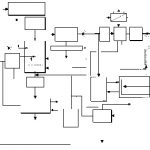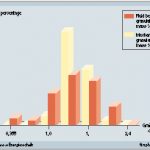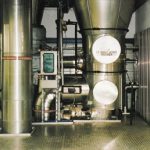In the semi-finished and finished products sector many branches of the industry are moving away from powder towards the compact granules form. Fluid bed technology provides for the granulation of complex systems of materials when combined with elements of heat technology.
Dr.-Ing. Jörg Kliefoth
In comparison with substances in powder form granules offer higher settled bulk densities and thus a greater concentration of constituents. This results in a smaller space requirement for storage and shipment. The virtually dust-free pourable products also lead to a reduction in the additional equipment required for dust extraction. Fluid bed technology offers a wide range of options for granules production. In addition to roasting and sizing, granules can also be produced using solutions, melts or suspensions. The drying and granulation of pastes can also be carried out in the fluid bed as well as granulation drying with simultaneous sizing. Combining this with elements of heat technology and the supply of energy makes use of the classical fluid bed principle in conformity with the stringent standards of the emission protection requirements.
Waste water treatment using granulation
Another example for the use of fluid bed granulation drying is the treatment of waste water containing solids. Systems of materials which offer thermal stability in the temperature range between 100 °C to 140 °C can be treated in the hot vapour circuit. The injected water vapour generates the fluid bed in which the granules are formed. The exhaust vapours are extracted via an overhead system and condensed out after the dust separation process. The flow of waste gas complies with the emission protection requirements. The solid constituents recovered using this process and the condensate can be reused as aggregates or industrial water. Sufficient wetting of the forming granules and turbulent mixing in the fluid bed ensures a uniform temperature distribution for the solid grain near the condensation point and for uniform grain growth. The delivery grain size is sufficient due to the self-nucleation process in the dryer and the dust recycling system. In the hot vapour system for example dye rinsing water and residues from fermentation processes can be granulated to produce a process auxiliary. If dryer inlet temperatures in excess of 200 °C and outlet temperatures of approx. 115 °C can be provided using a 25 bar vapour network, it is also possible to treat waste water with low concentrations of solids.
Special requirements
If no hot vapour network is available for granulation at the plant, water vapour has to be generated using a suitable system. Thermal oil can be used as the heat transfer medium for temperatures between 200 °C and 380 °C. However, at the same time it is necessary to find a solution to the product-specific NOx problem. When treating alkaline solutions (Fig. 1), the non-catalytic process (SNR), which makes use of the NH3 vapours produced during drying, is a practical alternative to selective catalytic reduction (SCR). However, in many cases it is sufficient to dispose of the waste gas using a thermal post-combustion system in the company’s own power house. Additional explosion-protection classification requirements stipulate costly peripheral systems technology for the granulation and drying processes. In the case of large-scale drying plants and systems for the foodstuffs / pharmaceutical industry and chemicals sector there may be a sharp increase in equipment costs due to requirements for CIP facilities including the associated control systems.
Special requirements are also involved in the treatment of thermolabile products which can only be dried and granulated at less than 100 °C. Only low inlet temperatures linked with reduced fluid bed speeds can be used in this case.
High grain quality
The diagram in figure 2 shows the attainable grain quality in comparison with mechanical granulation processes irrespective of the plant circuit configuration. However, in most cases it is necessary to perform external nucleus recycling with comminution and fraction separation of oversize and undersize particles. This type of granulation is often necessary in the case of applications with substances of high organic concentration as there is insufficient self-nucleation when using methods of spray agglomeration and solids abrasion. To perform granulation under a steady-state condition it is necessary to install extensive container and conveying systems.
Plant design
Figure 3 shows the structure of the drying chamber in a fluid bed granulator. Process technology modifications are necessary depending on the system of materials. A wide range of combinations is available to heat the drying agent in the circulation gas cleaning system. The methods used are cyclone or filter technology, heating of the conveying ducts, or the jet system if required in combination with preheated feed products. Depending on the product it may be necessary to use extensive container and powder technology to control the granulation processes.
With high dryer throughputs it will not be possible to do without automatic powder and silo systems. These ensure that the grain formation processes take place via fluid bed granulation with sizing grain delivery under steady-state conditions. The few examples demonstrate the wide range of possible systems engineering solutions offered by fluid bed technology. It is essential to clarify all aspects of the outline conditions such as product characteristics, capacity requirements, feasibility studies and plant location for the structure of the systems and process engineering described. Structured engineering will help to identify unused potential, eliminate costly shortcomings and assess risks for all parties at an early stage.
Haase Energietechnik
Fax: ++49/4321/8 78 29
Further information cpp-202
Unsere Webinar-Empfehlung
Die Websession „Wasserstoff in der Chemie – Anlagen, Komponenten, Dienstleistungen“ (hier als Webcast abrufbar) zeigt technische Lösungen auf, die die Herstellung und Handhabung von Wasserstoff in der chemischen Industrie sicher machen und wirtschaftlich gestalten.
Ob effizienter…
Teilen:













